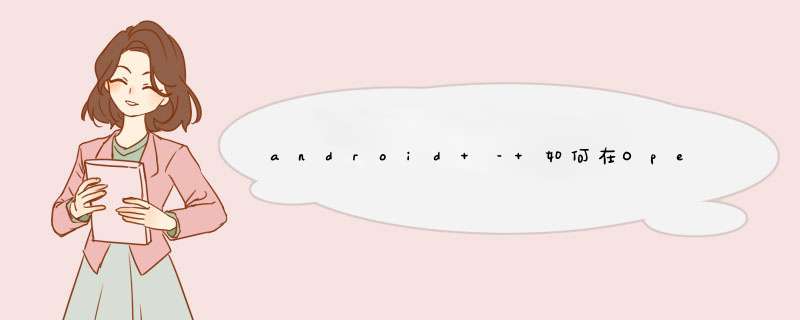
我发现很多教程,但是没有一个解释清楚如何在每个面上放置不同的纹理,没有一个给出了如何做的简单的代码示例.
我的实际代码(来自nehe的例子)在每个面上绘制一个具有相同纹理的立方体:
public class Cube {/** The buffer holding the vertices */private floatBuffer vertexBuffer;/** The buffer holding the texture coordinates */private floatBuffer textureBuffer;/** The buffer holding the indices */private ByteBuffer indexBuffer;/** Our texture pointer */private int[] textures = new int[1];/** * The initial vertex deFinition * * Note that each face is defined,even * if indices are available,because * of the texturing we want to achIEve */ private float vertices[] = { //Vertices according to faces -1.0f,-1.0f,1.0f,//Vertex 0 1.0f,//v1 -1.0f,//v2 1.0f,//v3 1.0f,//... 1.0f,};/** The initial texture coordinates (u,v) */ private float texture[] = { //MapPing coordinates for the vertices 0.0f,0.0f,};/** The initial indices deFinition */ private byte indices[] = { //Faces deFinition 0,1,3,2,//Face front 4,5,7,4,6,//Face right 8,9,11,8,10,//... 12,13,15,12,14,16,17,19,18,20,21,23,22,};/** * The Cube constructor. * * Initiate the buffers. */public Cube() { // ByteBuffer byteBuf = ByteBuffer.allocateDirect(vertices.length * 4); byteBuf.order(ByteOrder.nativeOrder()); vertexBuffer = byteBuf.asfloatBuffer(); vertexBuffer.put(vertices); vertexBuffer.position(0); // byteBuf = ByteBuffer.allocateDirect(texture.length * 4); byteBuf.order(ByteOrder.nativeOrder()); textureBuffer = byteBuf.asfloatBuffer(); textureBuffer.put(texture); textureBuffer.position(0); // indexBuffer = ByteBuffer.allocateDirect(indices.length); indexBuffer.put(indices); indexBuffer.position(0);}/** * The object own drawing function. * Called from the renderer to redraw this instance * with possible changes in values. * * @param gl - The GL Context */public voID draw(GL10 gl) { //Bind our only prevIoUsly generated texture in this case gl.glBindTexture(GL10.GL_TEXTURE_2D,textures[0]); //Point to our buffers gl.glEnableClIEntState(GL10.GL_VERTEX_ARRAY); gl.glEnableClIEntState(GL10.GL_TEXTURE_COORD_ARRAY); //Set the face rotation gl.glFrontFace(GL10.GL_ccw); //Enable the vertex and texture state gl.glVertexPointer(3,GL10.GL_float,vertexBuffer); gl.glTexCoordPointer(2,textureBuffer); //Draw the vertices as triangles,based on the Index Buffer information gl.glDrawElements(GL10.GL_TRIANGLES,indices.length,GL10.GL_UNSIGNED_BYTE,indexBuffer); //disable the clIEnt state before leaving gl.gldisableClIEntState(GL10.GL_VERTEX_ARRAY); gl.gldisableClIEntState(GL10.GL_TEXTURE_COORD_ARRAY);}/** * Load the textures * * @param gl - The GL Context * @param context - The Activity context */public voID loadGLTexture(GL10 gl,Context context) { //Get the texture from the AndroID resource directory inputStream is = context.getResources().openRawResource(R.drawable.nehe); Bitmap bitmap = null; try { //BitmapFactory is an AndroID graphics utility for images bitmap = BitmapFactory.decodeStream(is); } finally { //Always clear and close try { is.close(); is = null; } catch (IOException e) { } } //Generate one texture pointer... gl.glGenTextures(1,textures,0); //...and bind it to our array gl.glBindTexture(GL10.GL_TEXTURE_2D,textures[0]); //Create Nearest Filtered Texture gl.glTexParameterf(GL10.GL_TEXTURE_2D,GL10.GL_TEXTURE_MIN_FILTER,GL10.GL_NEAREST); gl.glTexParameterf(GL10.GL_TEXTURE_2D,GL10.GL_TEXTURE_MAG_FILTER,GL10.GL_liNEAR); //Different possible texture parameters,e.g. GL10.GL_CLAMP_TO_EDGE gl.glTexParameterf(GL10.GL_TEXTURE_2D,GL10.GL_TEXTURE_WRAP_S,GL10.GL_REPEAT); gl.glTexParameterf(GL10.GL_TEXTURE_2D,GL10.GL_TEXTURE_WRAP_T,GL10.GL_REPEAT); //Use the AndroID glutils to specify a two-dimensional texture image from our bitmap glutils.texImage2D(GL10.GL_TEXTURE_2D,bitmap,0); //Clean up bitmap.recycle();}}解决方法 要使每个面都有不同的纹理,您需要单独渲染立方体的每个面.这意味着每个脸部需要设置纹理,然后渲染脸部(使用glDrawArrays或glDrawElements).所以它看起来像: glEnable(GL_TEXTURE_2D);... //maybe other state setup (like buffer bindings)glVertexPointer(...);glEnableClIEntState(GL_VERTEX_ARRAY);...for each(face of cube){ glBindTexture(GL_TEXTURE_2D,<face_texture>); glDrawArrays(...) or glDrawElements(...); //draw only a single face}gldisableClIEntState(GL_VERTEX_ARRAY);...gldisable(GL_TEXTURE_2D);... //maybe other state cleanup 如果它们需要不同的纹理,则不能在一个调用中渲染多维数据集的所有面.但是,您当然可以将它们全部保留在单个数组/ VBO中,并且只需使用glDrawArrays或glDrawElements的参数来选择相应的面,如上所述.
这是一个相当简单的伪代码示例,如果所有这些都听起来很陌生,您应该深入了解OpenGL,并在多维数据集的每个面上应用不同的纹理是您的最小问题.
编辑:好的,根据你更新的代码:首先,由于所有顶点的位置和texCoords存储在同一个数组中,我们不需要更改每个面.此外,您的索引数组似乎包含所有面部连续存储为每个面的6个索引(2个三角形).所有这一切使整个情况变得非常容易.只需将您现有的glDrawElements调用替换为所有面的循环:
for(i=0; i<6; ++i){ gl.glBindTexture(GL10.GL_TEXTURE_2D,texture[i]); //use texture of ith face indexBuffer.position(6*i); //select ith face //draw 2 triangles making up this face gl.glDrawElements(GL10.GL_TRIANGLES,indexBuffer);} 因此,对于每个面,我们选择其纹理,并且仅画出与该面对应的2个三角形.
一般来说,从代码示例中学习,而不是一本书或类似的东西,您至少应该确保您了解每行代码和每个函数参数的含义.只有这样,您才能够根据需要自由调整代码,并开发解决问题的解决方案.
总结以上是内存溢出为你收集整理的android – 如何在OpenGL ES 1.1上填充不同纹理的立方体的每一面?全部内容,希望文章能够帮你解决android – 如何在OpenGL ES 1.1上填充不同纹理的立方体的每一面?所遇到的程序开发问题。
如果觉得内存溢出网站内容还不错,欢迎将内存溢出网站推荐给程序员好友。
欢迎分享,转载请注明来源:内存溢出

 微信扫一扫
微信扫一扫
 支付宝扫一扫
支付宝扫一扫
评论列表(0条)